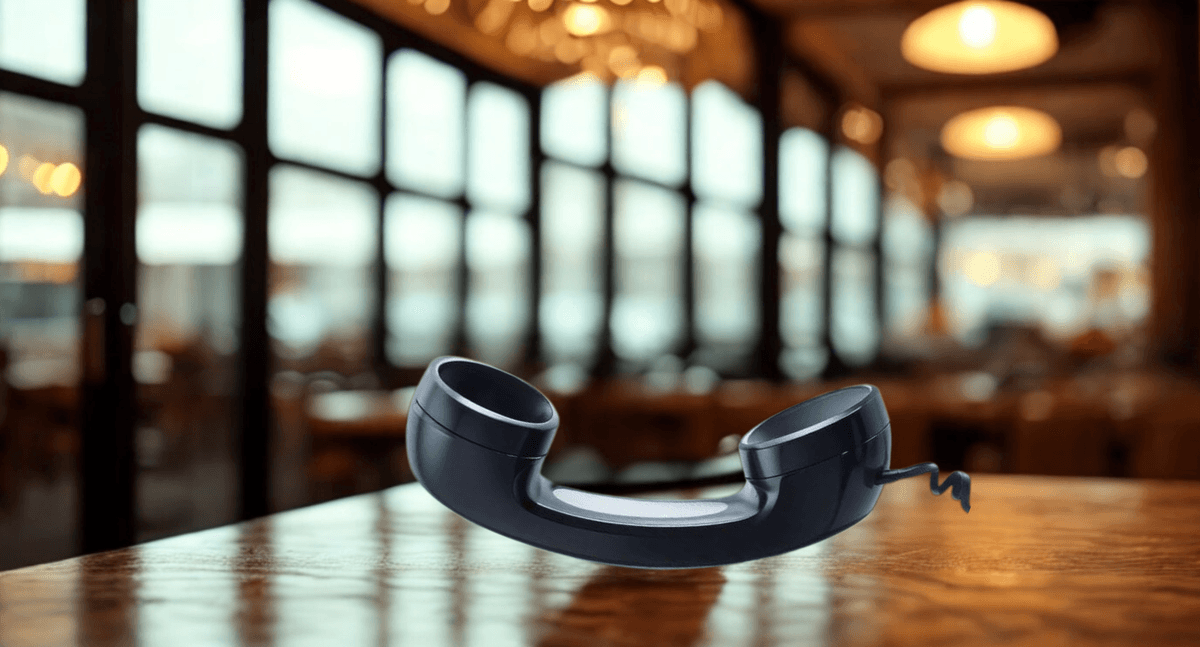
Never Miss a Customer Again: The ROI of AI for Restaurants
Boost revenue and customer satisfaction with AI for restaurants. See how AI agents turn missed calls into insights and growth.

Owning and running a successful restaurant requires hard work, long hours and a high-quality product — not to mention a lot of patience and determination. Restaurateurs often encounter challenges such as fluctuating food costs, high employee turnover, stiff competition, food safety and inventory management.
No wonder about 60 percent of restaurants fail in their first year of operation and 80 percent fail within five years. That doesn’t mean, though, that such defeat is inevitable, especially if you obtain— and retain — a loyal customer base.
Customer loyalty means more than catering to your regulars. It requires proactively implementing strategies to reward customers for choosing your establishment and encouraging those individuals to be loyal to your brand. Not only does the ability for increasing customer loyalty in your restaurant give you a competitive advantage and bolster revenue, but it also creates brand advocacy, saves on acquiring new customers and offers an easy way to procure customer feedback for continuous improvement.
To provide guidance on how to build a loyal customer base at your establishment, we’ve compiled a list of seven proven methods for boosting your restaurant’s customer loyalty.

Key Takeaways
Without excellent customer service, even the best food will not save a restaurant from its demise. Although the quality and range of food are two of the top five factors that impact restaurant customer loyalty, how your patrons are treated is a major driver of repeat business. It starts with your customers’ first impression when they walk in the door and spans the entire dining experience.
Ensuring your restaurant staff is appropriately trained is essential as is equipping them with the right resources. Create and maintain a documented customer service policy, verify that your servers are knowledgeable about your menu and gather feedback from your staff on any improvements that could be made to enhance your customers’ experience. Satisfied employees often lead to satisfied customers!

Cater to your customers by accommodating any special requests — within reason — from food allergy modifications to seating preferences. Confirm that your speed of service is consistent and that your restaurant offers a clean atmosphere in which customers can dine. When — not if — customer complaints occur, make sure they are handled promptly and professionally.
Want to know how you can turn customers away — literally? Lengthy wait times. It’s essential that you effectively manage wait times at your restaurant and be transparent with customers when a delay is inevitable. Technology such as conversational artificial intelligence (AI) allows you to optimize your seating capacity and automate bookings based on real-time table availability and track which tables are full, which are being cleaned and which are ready for new customers.
Restaurant customer loyalty programs might seem like a gimmick to some proprietors, but research has proven that these initiatives do indeed work. Don’t just take our word for it; 96 percent of customers surveyed by the National Restaurant Association report that participating in a restaurant loyalty program is a good way to earn more “bang for their buck.”
If you haven’t already implemented a restaurant customer loyalty program, consider that it can increase visits to your restaurant by 35 percent and increase sales by 30 percent. In addition to creating a sense of exclusivity for your patrons, loyalty programs generate an average of 4.9X more revenue than what they cost.

Although loyal customers typically spend 67 percent more than new guests, these popular loyalty programs also help attract new customers. More than 40 percent of consumers report that customer loyalty programs motivate them to try a new restaurant.
Not sure what type of customer loyalty program is a good fit for your restaurant? Those through which customers track their rewards and/or points on an app are especially popular. Others consist of classic punch card loyalty programs or ones integrated with point-of-sale (POS) systems. POS loyalty programs enable you to easily track and collect data and offer targeted and personalized rewards based on order preferences and history. Incentives you can offer as part of your customer loyalty program comprise exclusive discounts, birthday rewards, daily specials or free products (i.e., a free appetizer).
Gamification, which entails turning customer loyalty activities into a game, enables your customers to receive more rewards the more they participate in your loyalty program. It often spurs customers’ competitive nature while providing them with a sense of achievement by providing them with an incentive to engage.

The two most common examples of gamification encompass rewards for amount of points and number of purchases. Restaurants benefit from loyalty gamification by building brand awareness, saving on customer acquisition cost, increasing guest expenditures and driving brand loyalty.
A bonus? A boost in customer engagement. Brands employing gamification as part of their restaurant customer loyalty program achieve a 47 percent increase in engagement and a 22 percent surge in brand loyalty.
Everyone wants to feel valued, and restaurant patrons certainly are no exception. Customers these days expect personalization along with convenience, so your restaurant needs to stand out among the crowd by differentiating itself from competitors.
Just how can you accomplish this? By making your restaurant memorable to existing customers and new ones. Sometimes it can be as simple as remembering a customer’s name and favorite dish. In other cases, it might involve personalizing offers based on a customer’s preferences.

Often, employing customer data acquired through purchase histories, loyalty program rewards redemptions, points balances and marketing responses allows you to more accurately personalize offers for your existing customers. Restaurants that utilize conversational AI can utilize customer data to create targeted marketing campaigns or send specific messages to consumers based on their past visits to and orders at the restaurant. This data also can be utilized to know which audience a restaurant should target for a special event.
More than 80 percent of consumers are receptive to personalized messages, and nearly half are likely to switch brands for more relevant, personalized offers. Similarly, 91 percent of consumers are more likely to do business with brands —including restaurants — that recognize, remember and provide them with relevant offers and recommendations.
These days, restaurants must reach customers where they are, and often that’s on social media. Consumers prefer brands that interact with them through their preferred channels of communication, so personalizing your brand on platforms such as Facebook, Instagram, X and TikTok puts you in front of the target audience.
Interacting with current and potential restaurant patrons on social media requires some planning, but sharing behind-the-scenes content, conducting polls, running contests and offering exclusive access maximizes engagement and drives customer loyalty. There’s research to back this up, too. Seventy percent of customers have visited a restaurant based on recommendations they saw on social media, and restaurants that respond to social media comments and reviews report a 25 percent increase in customer satisfaction.
Instagram is an especially popular social media option for restaurant-goers. Sixty percent of restaurants that use Instagram report a noticeable increase in reservations.

Don’t just use social media to promote your successful restaurant, though. Encourage your customers to leave reviews to boost your online presence. Approximately 94 percent of consumers check online reviews before visiting a restaurant.
Deploying technology resources enables you to provide the accessibility and convenience customers expect from your restaurant. Without tools that streamline reservations, ordering, payment and other parts of the dining experience, you risk losing loyal customers to competing restaurants that offer a more seamless experience.
Proactively engaging with customers through conversational AI allows you to deliver personalized messaging at scale without overloading your staff. It performs routine and repetitive tasks, giving those staff members more time to focus on top-shelf customer service that fosters loyalty to your establishment.

Loyal customers typically have favorite menu items or at least stick to the same sort of cuisine. Conversational AI agents can make menu recommendations based on diners’ previous orders, thereby promoting customer satisfaction.
Such AI tools also enable patrons to provide immediate feedback after their meal, which enables restaurants to personalize future meals for those individuals, again driving customer loyalty.
Keeping members on the roster is as important as putting new members on it. Revmo can help drive engagement with potential customers and promote loyalty with existing ones.
Now’s the time to integrate conversational AI into your recipe for success. Give a Revmo AI Engineer a call right now to add the perfect ingredient to build customer loyalty at your restaurant.
Creating a memorable dining experience for your restaurant customers involves personal touches, attention to detail, and emphasizing unique aspects of your establishment. For example, you could use guests’ names, remember their favorite dishes, and offer small pre-service gifts. These efforts make customers feel valued and appreciated.
Staff training is important for customer loyalty because well-trained employees can deliver excellent customer service, build rapport, retain customers, and create personalized experiences, leading to a consistent and positive customer experience. This ultimately fosters customer loyalty.
Restaurants can implement punch card programs, using online ordering apps, credit card-linked systems and loyalty programs integrated with POS systems to track customer behavior, offer rewards and streamline operations. Using modern POS systems can enhance the effectiveness of these programs.
As its name indicates, gamification utilized in loyalty programs draws from elements of gaming. The goal of gamification in the restaurant industry and customer loyalty programs is to make the process of completing “missions” and subsequently earning points or rewards entertaining. Perks of loyalty program gamification include boosted brand awareness, increased conversion rates and improved engagement for more repeat business.
Some of the most effective loyalty program gamification tactics consist of friend referral and tier-level challenges, badges and trophies, spin-to-win games, code words, and quizzes. These approaches create and maintain interest in your brand to encourage customers, build repeat business, and maintain a large following of customers.
You can use customer feedback to improve your restaurant by responding to feedback, making improvements based on customer preferences and suggestions and demonstrating changes, which enhances customer loyalty and satisfaction.
Technology plays a crucial role in enhancing the customer experience by providing convenience, streamlining operations, supporting various payment methods, automating tasks and integrating with loyalty programs to improve customer loyalty and reward repeat customers effectively. This ultimately leads to a more seamless and satisfying customer interaction.
By combining advanced automation, AI, and natural language processing (NLP) to enable comprehension of and response to human language, voice-enabled conversational AI automates more natural, human-like interactions between computers and users.
In addition to being equipped to provide a more flexible conversational flow, conversational AI technology learns from information gathered and is built to understand patterns of human behavior.
An easily scalable technology, conversational AI platforms enable restaurant owners with multiple locations or service areas to improve operational efficiency and deliver higher levels of customer service.
Along with performing some routine tasks, AI helps restaurant operators predict labor needs based on peak business hours. This aids in optimizing labor spend while reducing employee burnout.
Conversational AI also can be employed at restaurants to automatically answer customer calls 24/7, conduct inventory management, send specific messages to consumers based on their past visits and orders at the restaurant, improve reservation and table management and enable customers to provide immediate feedback after their meal.

Boost revenue and customer satisfaction with AI for restaurants. See how AI agents turn missed calls into insights and growth.


